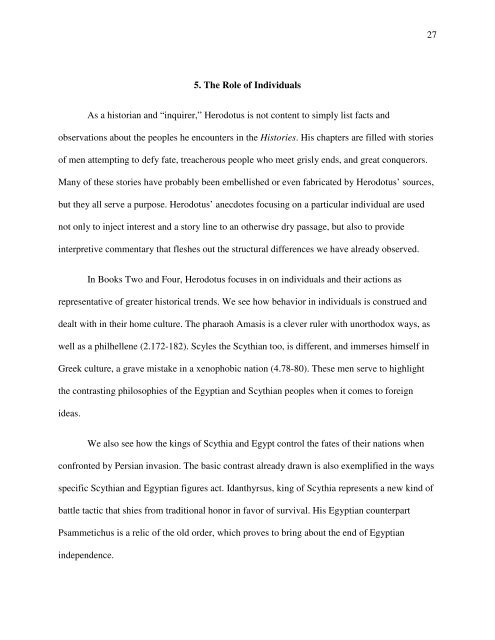The Old and the Restless - The Egyptians and the Scythians in Herodotus' Histories by Robert J. Hagan
You also want an ePaper? Increase the reach of your titles
YUMPU automatically turns print PDFs into web optimized ePapers that Google loves.
27<br />
5. <strong>The</strong> Role of Individuals<br />
As a historian <strong>and</strong> “<strong>in</strong>quirer,” Herodotus is not content to simply list facts <strong>and</strong><br />
observations about <strong>the</strong> peoples he encounters <strong>in</strong> <strong>the</strong> <strong>Histories</strong>. His chapters are filled with stories<br />
of men attempt<strong>in</strong>g to defy fate, treacherous people who meet grisly ends, <strong>and</strong> great conquerors.<br />
Many of <strong>the</strong>se stories have probably been embellished or even fabricated <strong>by</strong> Herodotus’ sources,<br />
but <strong>the</strong>y all serve a purpose. Herodotus’ anecdotes focus<strong>in</strong>g on a particular <strong>in</strong>dividual are used<br />
not only to <strong>in</strong>ject <strong>in</strong>terest <strong>and</strong> a story l<strong>in</strong>e to an o<strong>the</strong>rwise dry passage, but also to provide<br />
<strong>in</strong>terpretive commentary that fleshes out <strong>the</strong> structural differences we have already observed.<br />
In Books Two <strong>and</strong> Four, Herodotus focuses <strong>in</strong> on <strong>in</strong>dividuals <strong>and</strong> <strong>the</strong>ir actions as<br />
representative of greater historical trends. We see how behavior <strong>in</strong> <strong>in</strong>dividuals is construed <strong>and</strong><br />
dealt with <strong>in</strong> <strong>the</strong>ir home culture. <strong>The</strong> pharaoh Amasis is a clever ruler with unorthodox ways, as<br />
well as a philhellene (2.172-182). Scyles <strong>the</strong> Scythian too, is different, <strong>and</strong> immerses himself <strong>in</strong><br />
Greek culture, a grave mistake <strong>in</strong> a xenophobic nation (4.78-80). <strong>The</strong>se men serve to highlight<br />
<strong>the</strong> contrast<strong>in</strong>g philosophies of <strong>the</strong> Egyptian <strong>and</strong> Scythian peoples when it comes to foreign<br />
ideas.<br />
We also see how <strong>the</strong> k<strong>in</strong>gs of Scythia <strong>and</strong> Egypt control <strong>the</strong> fates of <strong>the</strong>ir nations when<br />
confronted <strong>by</strong> Persian <strong>in</strong>vasion. <strong>The</strong> basic contrast already drawn is also exemplified <strong>in</strong> <strong>the</strong> ways<br />
specific Scythian <strong>and</strong> Egyptian figures act. Idanthyrsus, k<strong>in</strong>g of Scythia represents a new k<strong>in</strong>d of<br />
battle tactic that shies from traditional honor <strong>in</strong> favor of survival. His Egyptian counterpart<br />
Psammetichus is a relic of <strong>the</strong> old order, which proves to br<strong>in</strong>g about <strong>the</strong> end of Egyptian<br />
<strong>in</strong>dependence.
















